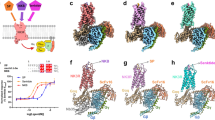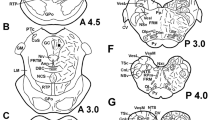Summary
-
1.
The possible existence of multiple receptors for substance P (SP) was investigated by examining the relative pharmacological potencies of SP and related peptides in contracting guinea pig ileum, in potentiating electrically evoked contractions of rat vas deferens preparations and in competing for 3H-SP receptor binding in rat brain membranes, and by comparing the extent of cross-tachyphylaxis of various analogues with SP in the guinea pig ileum.
-
2.
Different rank orders of potencies were observed among SP, its C-terminal fragments, analogues and related tachykinins in the different test systems, and these could not be explained by differential access to the target organ receptors.
-
3.
In contrast to SP and physalaemin, both eledoisin and a metabolically stable SP analogue, [pGlu5, MePhe8, Sar9]-SP5-11 exhibited differential recovery from SP tachyphylaxis in the guinea pig ileum, and part of their spasmogenic action in this preparation was atropine-sensitive.
-
4.
The results suggest the possible existence of multiple SP receptors, and the specificity of those in the brain may be different from those in the gut. The structural and pharmacological basis for subdividing tachykinins into SP-physalaemin and eledoisin-kassinin families is also discussed.
Similar content being viewed by others
References
Bergmann J, Oehme P, Bienert M (1979) Untersuchungen zur biologischen Aktivität und zum Wirkungsmechanismus von Substanz P-Analogen an glattmuskulären Organen. Pharmazie 34:344
Bertaccini G (1976) Active polypeptides of nonmammalian origin. Pharmacol Rev 38:127–177
Blackwell M, James TA, Starr MS (1978) Potentiation by substance P of contractions of the isolated vas deferens of the mouse elicited by electric field stimulation and by drugs. Br J Pharmacol 63:323–329
Bury RW, Mashford ML (1976) Biological activity of C-terminal partial sequences of substance P. J Med Chem 19:854–856
Bury RW, Mashford ML (1977) A pharmacological investigation of synthetic substance P on the isolated guinea pig ileum. Clin Exp Pharmacol Physiol 4:453–461
Couture R, Fournier A, Magnan J, St-Pierre S, Regoli D (1979) Structure-activity studies on substance P. Can J Physiol Pharmacol 57:1427–1436
DeCaro G, Massi M, Micossi LG (1980) Modifications of drinking behaviour and of arterial blood pressure induced by tachykinins in rats and pigeons. Psychopharmacol 68:243–247
Erjavec F, Lembeck F, Florianc-Irman T, Skofitsch G, Donnerer J, Saria A, Holzer P (1981) Release of histamine by substance P. Naunyn-Schmiedeberg's Arch Pharmacol 317:67–70
Erspamer V, Falconieri Erspamer G, Linari G (1977) Occurrence of tachykinins (physalaemin or substance P-like peptides) in the amphibian skin and their actions on smooth muscle preparations. In: von Euler US, Pernow B (eds) Substance P. Raven Press, New York, pp 67–74
Falconieri Erspamer G, Erspamer V, Piccininelli D (1980) Parallel bioassay of physalaemin and kassinin, a tachykinin dodecapeptide from the skin of the African frog Kassina senegalensis. Naunyn Schmiedebergs Arch Pharmacol 311:61–65
Folkers K, Horig J, Rosell S, Bjorkroth U (1981) Chemical design of antagonists of substance P. Acta Physiol Scand 111:505–506
Franco R, Costa M, Furness JB (1979) Evidence for the release of endogenous substance P from intestinal nerves. Naunyn-Schmiedeberg's Arch Pharmacol 306:195–201
Gillespie JS, McKnight AT (1978) The actions of some vasoactive polypeptides and their antagonists on the anococcygeus muscle. Br J Pharmacol 62:267–274
Growcott JW, Petter NN (1980) Tachyphylaxis due to the d-Phe7 analogue of substance P. J Pharm Pharmacol 32:376–377
Hanley MR, Iversen LL (1980) Substance P receptors. In: Enna SJ, Yamamura HI (eds) Receptors and recognition, Series B, vol 9. Neurotransmitter receptors. Part Lamino acids, peptides and benzodiazepines. Chapman and Hall, London, pp 71–103
Hanley MR, Sandberg BEB, Lee CM, Iversen LL, Brundish DE, Wade R (1980a) Specific binding of 3H-substance P to rat brain membranes. Nature (Lond) 286:810–812
Hanley MR, Lee CM, Jones LM, Michell RH (1980b) Similar effects of substance P and related peptides on salivation and on phosphatidylinositol turnover in rat salivary glands. Mol Pharmacol 18:78–83
Holzer P, Lembeck F (1979) Effect of neuropeptides on the efficiency of the peristaltic reflex. Naunyn-Schmiedeberg's Arch Pharmacol 307:257–264
Holzer P, Lembeck F (1980) Neurally mediated contraction of ileal longitudinal muscle by substance P. Neurosci Lett 17:101–105
Jensen RT, Gardner JD (1979) Interaction of physalaemin, substance P and eledoisin with specific membrane receptors on pancreatic acinar cells. Proc Natl Acad Sci USA 76:5679–5683
Johnson AR, Erdos EG (1973) Release of histamine from mast cells by vasoactive peptides. Proc Soc Exp Biol Med 142:1252–1256
Kaneto A, Kaneko T, Kajinuma H, Kosaka K (1978) Effect of substance P and neurotensin infused intrapancreatically on glucagon and insulin secretion. Endocrinology 120:393–401
Lembeck F, Zetler G (1962) Substance P: A polypeptide of possible physiological significance especially within the nervous system. Int Rev Neurobiol 4:159–215
Lembeck F, Fischer G (1967) Gekreuzte Tachyphylaxie von Peptiden. Naunyn-Schmiedeberg's Arch Pharmacology 258:452–456
Milenov K, Oehme P, Bienert M, Bergmann J (1978) Effects of substance P on mechanical and myoelectrical activities of stomach and small intestines in conscious dog. Arch Int Pharmacodyn Ther 233:251–260
Nakata Y, Kusaka Y, Yajima H, Kitagawa K, Segawa T (1980) Further characterization of the binding of substance P to a fraction from rabbit brain enriched in synaptic membranes. Naunyn-Schmiedeberg's Arch Pharmacol 314:211–214
Nicoll RA, Schenker C, Leeman SE (1980) Substance P as a transmitter candidate. Ann Rev Neurosci 3:227–268
Otsuka M, Konishi S, Takahashi T (1975) Hypothalamic substance P as a candidate for transmitter of primary afferent neurones. Fed Proc 34:1922–1928
Rosell S, Bjokroth U, Chang D, Yamaguchi I, Wan Y-P, Rackur G, Fisher G, Folker K (1977) Effects of substance P and analogs on isolated guinea pig ileum. In: Von Euler US, PernowB (eds) Substance P. Raven Press, New York, pp 83–88
Rosell S, Olgart L, Gazelius B, Panopoulos P, Folker K, Horig J (1981) Inhibition of antidromic and substance P-induced vasodilatation by a substance P antagonist. Acta Physiol Scand 111:381–382
Sandberg BEB, Lee CM, Hanley MR, Iversen LL (1981) Synthesis and biological properties of enzyme-resistant substance P analogues. Eur J Biochem 114:329–337
Schild HO (1973) Receptor classification with special reference to beta adrenergic receptors. In: Rang HP (ed) Drug receptors. University Park Press, Baltimore, pp 29–36
Spearman TN, Pritchard ET (1977) Potassium release from submandibular salivary gland in vitro. Biochim Biophys Acta 466:198–207
Stephenson RP (1956) A modification of receptor theory. Br J Pharmacol 11:379–393
Teichberg VI, Cohen S, Blumberg S (1981) Distinct classes of substance P receptors revealed by a comparison of the activities of substance P and some of its segments. Regulatory Peptides 1:324–333
Von Euler US, Gaddum JH (1931) An unidentified depressor substance in certain tissue extracts. J Physiol 72:74–87
Zetler G, Kampmann E (1979) An attempt to differentiate the effects of angiotensin II, substance P and bradykinin on the field stimulated guinea pig vas deferens. Eur J Pharmacol 56:21–29
Author information
Authors and Affiliations
Rights and permissions
About this article
Cite this article
Lee, CM., Iversen, L.L., Hanley, M.R. et al. The possible existence of multiple receptors for substance P. Naunyn-Schmiedeberg's Arch. Pharmacol. 318, 281–287 (1982). https://doi.org/10.1007/BF00501166
Received:
Accepted:
Issue Date:
DOI: https://doi.org/10.1007/BF00501166




